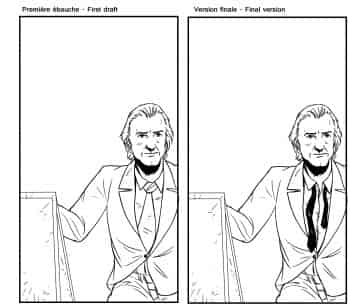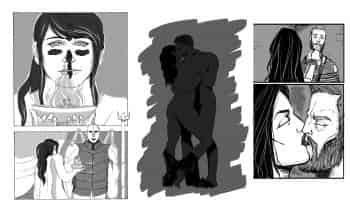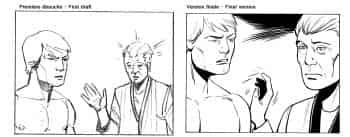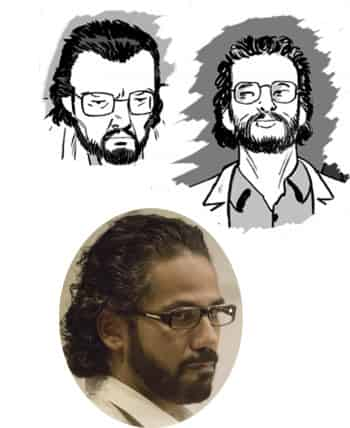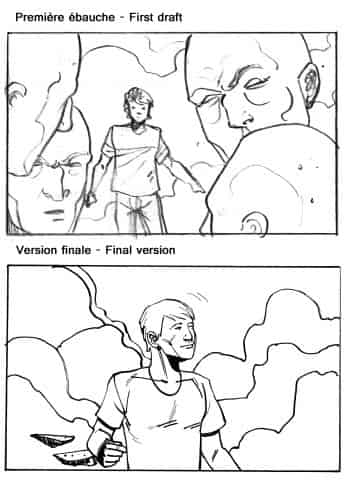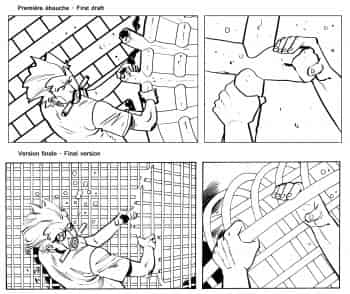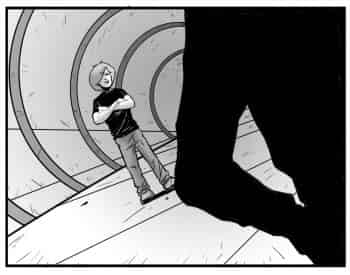
Image
Touch-ups (Clearly—Part I)
Comics are a collaborative effort. The scriptwriter can ask for corrections to an illustration to maintain the overall consistency. In the heat of the action, our illustrator had confused two characters, so Valasquez had a well-knotted tie, and Markham’s tie was undone, rather than the other way around. Valasquez’s tie was important there, as it indicated his level of exhaustion.
Women in control—Part IV
We like Gypsie because this character is not a prude and she uses her sexuality to get what she wants. She is talented at mental manipulation, but is more likely to use her body than her psychic abilities to achieve her goals. In that sense, her relationship with Travis was much more ambiguous than the one with Blascovitch. With the latter, sex was only a way for Gypsie to get favours. It was different with Travis. And while his death was predictable, it was still a shock for her.
Their ambiguous relationship may seem confusing. It’s Gypsie who dominates the couple, even though Travis (via Votan) is clearly more powerful. She gives Travis the ambition he seems to lack. There is of course an element of Lady Macbeth dormant in her. And Travis is simply stupid with love for her. He would do anything for her. Gypsie knows this and uses it to her advantage. But beyond the power that Votan confers onto Travis, and thus onto Gypsie herself, she is genuinely attached to Travis.
Touch-ups (“Psychological Warfare”—Part III)
Comics are a collaborative effort. The scriptwriter can ask for corrections to an illustration to maintain the overall consistency. For this panel, we had requested a square voiceover bubble, but the illustrator added some floating heads. We thought it was too early to introduce these ghost-like figures at this stage of the story, so we asked that the panel be cut.
Touch-ups (“Psychological Warfare”—Part II)
Comics are a collaborative effort. The scriptwriter can ask for corrections to an illustration to maintain the overall consistency. We had several discussions with the illustrator about the size of the bars keeping the aircraft from entering the Bunker. The bars had to be large enough to keep intruders out but not be so massive that they couldn’t be deformed by human strength.
Women in control —Part III
We continue our thoughts on the definition of a strong female character. In fact the word “strong” is not entirely appropriate: strength must fit into the character’s balance of strengths and weaknesses. Josef Siroka offers a similar analysis for films: “So, feminists shouldn’t have said, ‘We want more strong female characters.’ They should have said, ‘We want weaker female characters.’ Not weak in the ‘damsel in distress’ sense of the word, but weak as in having flaws (“Redéfinir le « personnage féminin fort» », http://blogues.lapresse.ca/moncinema/siroka, Feburary 11, 2014).
On a side note, the opposite of a strong woman character is one reduced to being only a damsel in distress. When we look at the Captain America film trilogy, we see that at no point do the women need saving by the superhero.
Back to the Apatrides universe, it’s Jenny who tells Markham she wants to go to a Black Orchestra training camp. At that point, she is the only character in the stories already posted, to volunteer for the camps and be fully aware of what she’s requesting.



